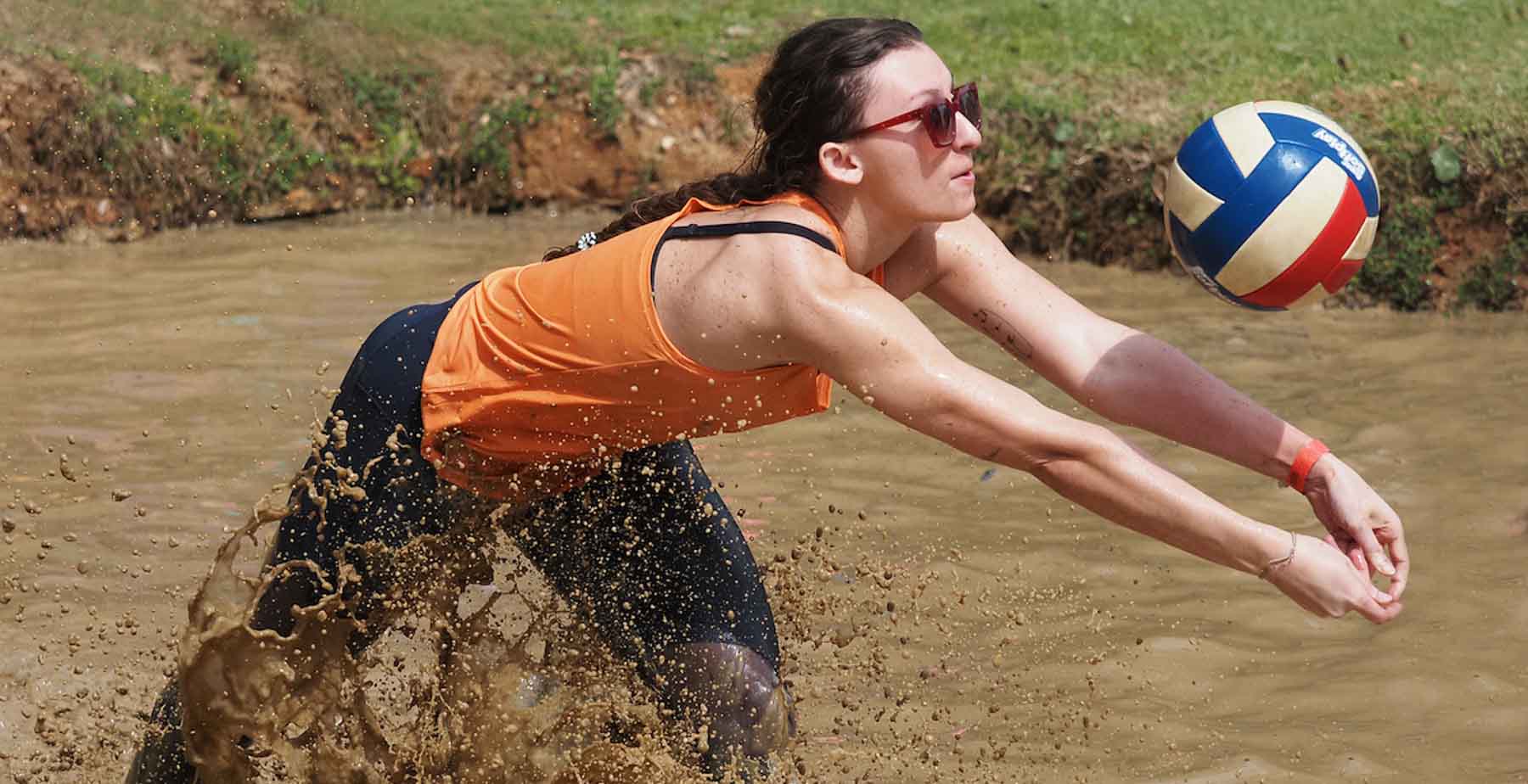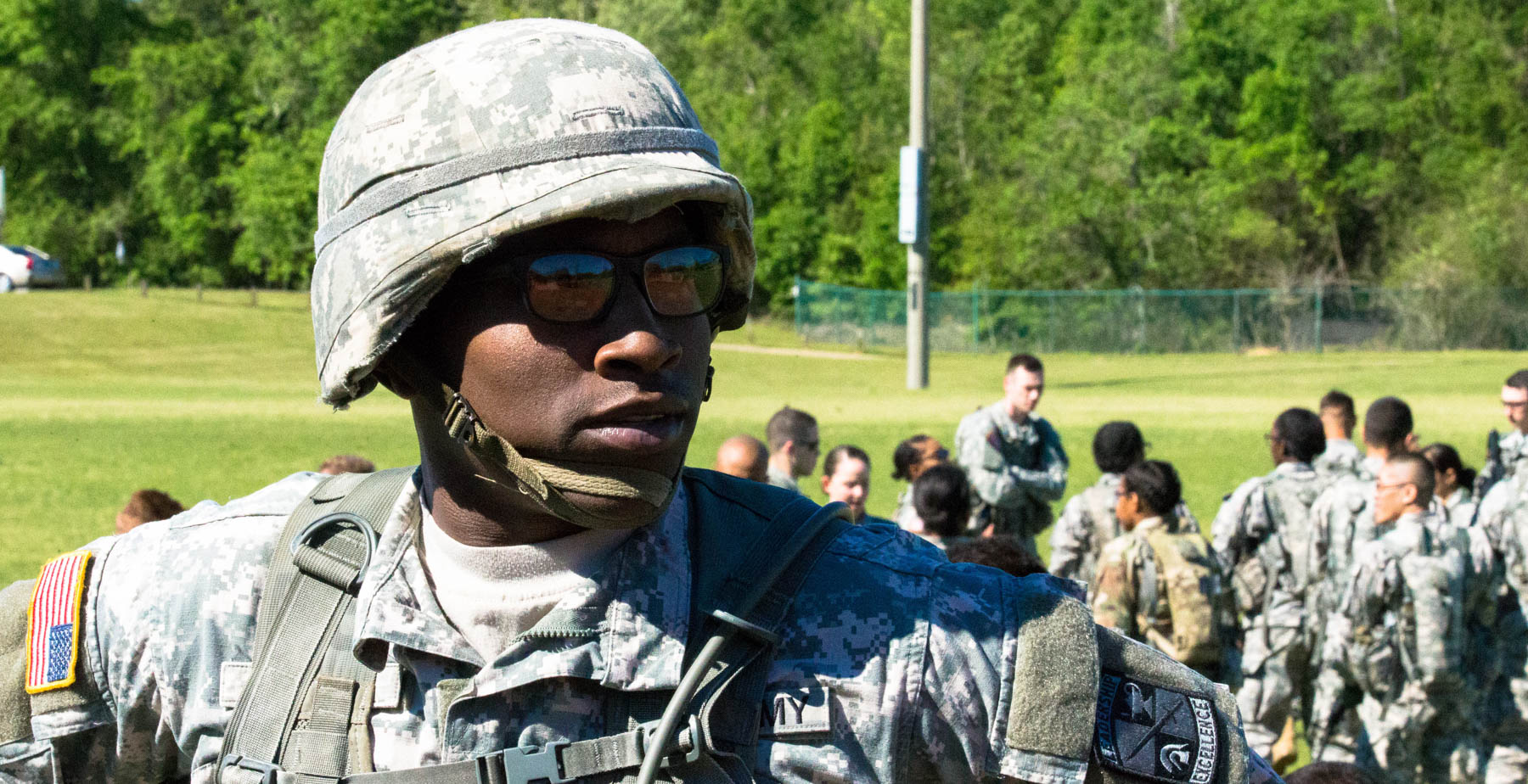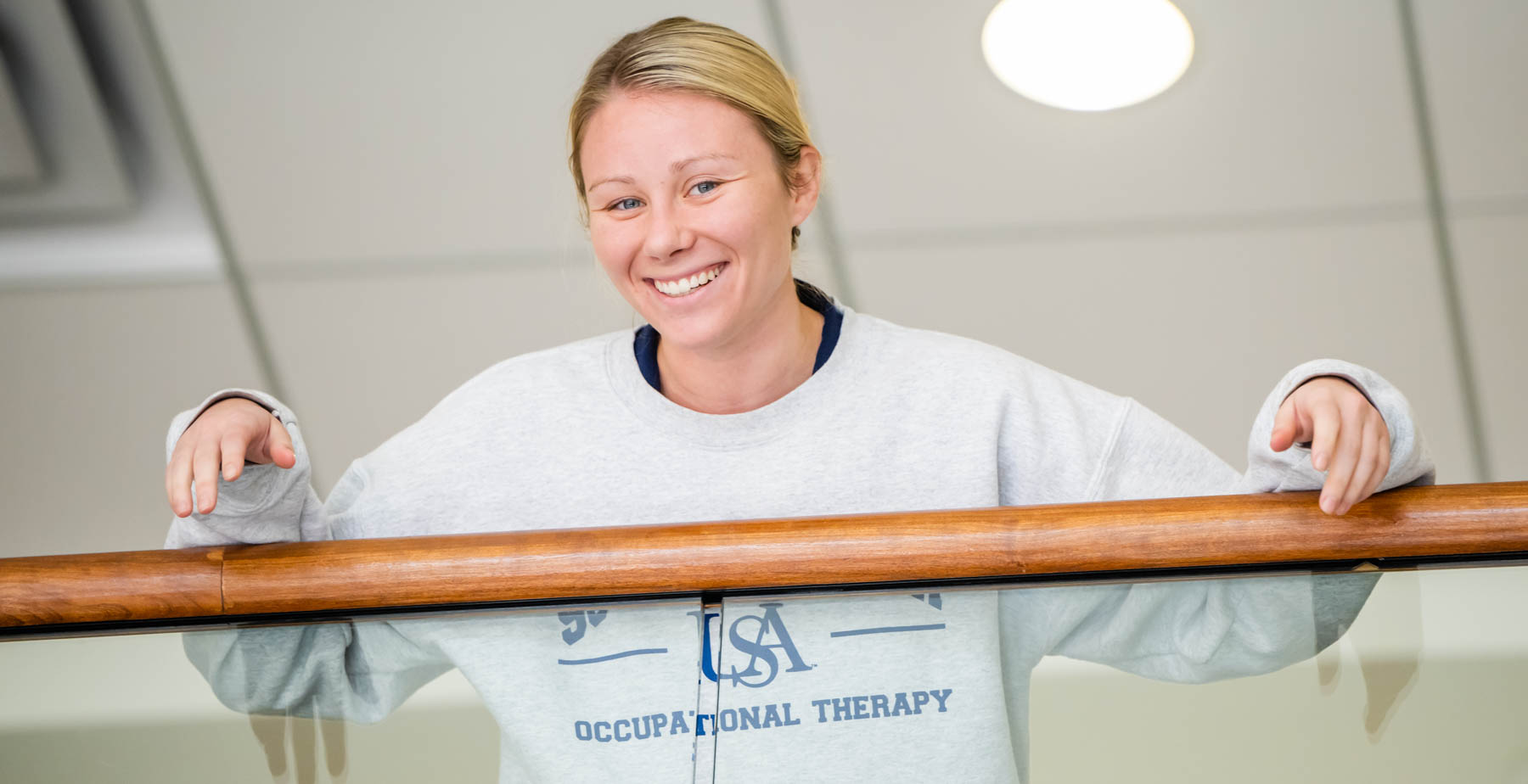A Halo for Abby
Posted on January 9, 2024

This story was originally published in the fall edition of South Magazine, a joint publication of the University of South Alabama and the USA National Alumni Association. Read more online.
A nurse and a nurse anesthetist wheel 7-year-old Abby Flowers into OR-1 at USA Health Children’s & Women’s Hospital. Over the next hour, a pediatric orthopaedic surgery team inserts eight pins into the young patient’s skull. Attached to the pins is a metal ring called a halo.
When Abby emerges from surgery, the halo is hooked to a pulley system, creating traction on her spine. The tension starts to correct a severe curvature of the spine, setting the stage for further treatment.
The procedure, which took place in August, is a first for Children’s & Women’s Hospital. What began with a family seeking pain relief for a little girl becomes a new service at the hospital that gives hope for children with similar severe spinal deformities.
Without it, the closest option for these patients is hours away.
“Our vision is to build this program up so that we can offer halo gravity traction to any kid who comes in,” said Dr. Tyler McDonald, Abby’s surgeon and an assistant professor of orthopaedic surgery in the Frederick P. Whiddon College of Medicine.
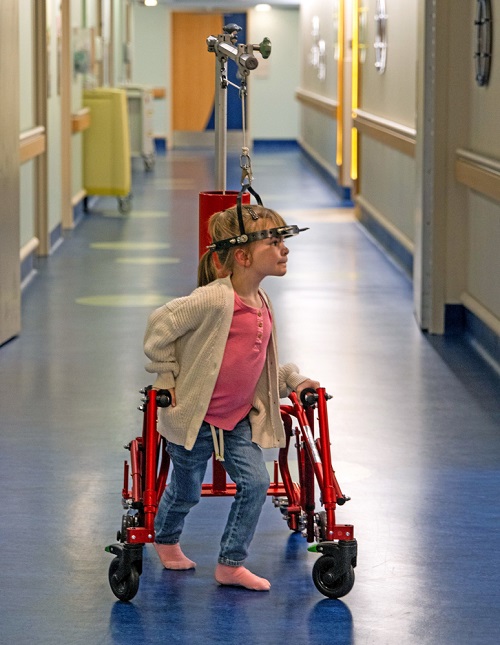 Abby Flowers navigates the halls of USA Health Children’s & Women’s Hospital with
the help of a halo gravity traction-equipped custom walker.
Abby Flowers navigates the halls of USA Health Children’s & Women’s Hospital with
the help of a halo gravity traction-equipped custom walker.
‘Heart Attacks’ and Heartache
Earlier in the year, Abby and her parents had arrived at USA Health’s Strada Patient Care Center in Mobile with a stack of medical records the size of a dictionary. The family, from Baldwin County, Alabama, met with McDonald and shared their fears and frustrations from the last two years.
Abby had undergone surgery at a Florida hospital to remove a benign tumor behind her lung. It was a ganglioneuroma, which develops in nerve cells. During her recovery, her parents had noticed something unusual about the kindergartener’s posture.
“She was miserable. I noticed she was leaning to one side,” recalled Abby’s mother, Monica Flowers. “I thought, ‘Maybe she’s in pain?’”
Imaging showed Abby’s spine was curving. She was outfitted with a corrective vest, but she couldn’t tolerate it. What followed were months of physical therapy, braces, massages and exercises. The family met with more doctors and discussed surgery but came away feeling frustrated. There was still a significant curve, and it was getting worse.
“It progressed to where her ribs were sticking out on one side,” Flowers said. “She was not eating well or gaining weight. And she was starting to have chest pain.”
One day, Flowers overheard her usually cheerful daughter playing, pretending to be a YouTube star, saying, “I have a lot of heart attacks, and they hurt every day.”
Flowers was mortified. “Abby was hurting on a consistent basis and keeping it to herself,” she said.
That’s when the family turned to USA Health. McDonald, a board-certified orthopaedic surgeon, had trained in halo gravity traction during his fellowship in pediatric orthopaedics and scoliosis at the Nemours Children’s Hospital, Delaware in Wilmington. He explained that the treatment could help, but it wasn’t offered at a lot of facilities.
“We don’t have that here,” he told the family frankly.
But Abby’s parents were already sold on McDonald’s knowledge and sincerity.
As the doctor listened to their requests, he knew what he had to do. “If you do want to have it here, I’ll have to build the program from scratch,” he said. “I’ll get to work.”
A Group Effort
Over the next few months, a collaboration began to take shape among the University of South Alabama and its academic health system to help Abby.
McDonald enlisted his immediate clinical team, nurse practitioner Amber Wicker and athletic trainer Cheyne Bush. Wicker took on the role of traffic cop, reaching out to the University’s Renovations unit for help with fabricating the needed equipment, and to the pediatric staff at Children’s & Women’s Hospital to let them know that something new was coming. Bush became the liaison to the Flowers family, keeping them informed about the team’s progress.
Soon, Daniel Greer and Bill Johnson in Renovations and Mike Towery of Fusion Welding, a local University vendor, were on board and building a prototype for a wheelchair and walker for Abby, who was almost 7 years old but weighed less than 40 pounds.
“They took on the project enthusiastically,” Wicker said. “It was new to us all, and they were patient as we worked through the details for the equipment. They were quick and proactive, and really made getting Abby what she needed a top priority.”
Not recommended for all patients with scoliosis, halo gravity traction addresses curvatures so severe that metal rods surgically attached to the spine likely would not hold. Patients are outfitted with a metal halo that encircles the head at eyebrow level and is attached to the skull with pins. The top is connected to a counterweight that helps lift the patient’s body weight off the spine.
The patient remains in traction, day and night, for weeks. The traction can straighten the spine enough that further surgery can be successful.
Greer, associate director of renovations and construction at South, offered to find funding for a walker that could fit Abby’s tiny frame. He and his staff gathered poles, mechanisms and weights from the hospital, along with carabiner clips from a local outdoors store. Someone in the University’s cabinetry shop located a pipe with just the right diameter to enclose the weights, and Towery offered his welding services.
Soon the walker and wheelchair were outfitted with hardware suspended over where Abby would stand and sit. The builders painted the walker cobalt blue and the wheelchair bright yellow to add an element of fun.
“What we got out of it was the satisfaction that we knew it was directly impacting somebody’s life,” Towery said.
‘Welcome, Flowers Family’
On July 21, in Room 477 at USA Health Children’s & Women’s Hospital, pediatric nurse educator Hannah Dennis wrapped a cloth strap around the head of her colleague Anna Whetstone, a petite physical therapist. A group of about 10 nurses, physical therapists and other staff crowded around to watch Dennis demonstrate how to clip the strap — a stand-in for the halo — to a rope and pulley system above the small hospital bed.
Dennis carefully showed the procedure for transferring the patient and strap to the tiny blue walker and yellow-framed wheelchair from Renovations. “The kiddo will be in traction the whole time, in bed, in the walker or the wheelchair,” she said.
She cued the group to form pairs and perform cranial screenings on each other. These exams would be used to monitor the patient for neurological issues as the traction progressed.
On a whiteboard nearby, a handwritten message read: “Welcome, Flowers family.”
It was nearly time for Abby to get her halo.
Design and Build
Across Mobile at the University’s College of Engineering, four mechanical engineering students jumped on a video conference with McDonald and Wicker.
“What would you like us to prioritize, the wheelchair or the walker?” asked Julia Nelson, a senior from Mobile.
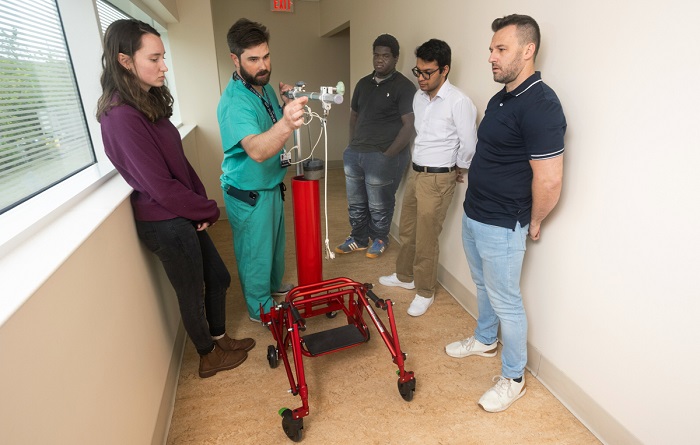 Engineering students, clockwise from left, Julia Nelson, Jalon McGhee, Ashwin Dahal
and Joshua Neese visit with Dr. Tyler McDonald, in scrubs, to look at the mechanics
of the walker used by Abby Flowers.
Engineering students, clockwise from left, Julia Nelson, Jalon McGhee, Ashwin Dahal
and Joshua Neese visit with Dr. Tyler McDonald, in scrubs, to look at the mechanics
of the walker used by Abby Flowers.
Nelson, along with Ashwin Dahal, Joshua Neese and Jalon McGhee, were designing and building more equipment for halo gravity traction. Their team-based capstone design project is the culmination of four years of undergraduate study in the William B. Burnsed Jr. Mechanical, Aerospace and Biomedical Engineering program.
The equipment they present at a spring symposium may help USA Health provide treatment for children like Abby who have severe spinal deformities.
“We want to have an arsenal of equipment ready to go and come up with the best way to transmit traction from the patient to the different devices,” McDonald said. “That’s what we can figure out together.”
The students were eager to get started.
“I chose this as my capstone project because creating a device that would be used in a real clinical setting and help improve someone’s quality of life sounded really exciting to me,” said Nelson, who plans to pursue biomedical research in graduate school. “Creating new technologies to help people live better lives is what engineering is all about.”
While the halo itself is a standard medical device, the equipment that is attached to a wheelchair, bed or walker varies, McDonald told the students. Some devices, like Abby’s, use a pulley system, while others rely on a spring to create the necessary tension.
“There are pros and cons of a pulley counterweight system,” he said. “A pulley system is easier to conceptualize from a nursing standpoint. If we need to increase the weight by two pounds, we put two more pounds on the pulley system. Easy.
“With a spring, if the patient hunkers down, it can put more tension on the spring than if they stand up,” he said.
Dahal said later that he had heard about scoliosis and had seen halo devices in videos. The project seemed to present a perfect opportunity to explore new ways to help patients.
“As our meeting progressed, I found myself growing more confident about our future project goals,” he said. “While I hadn’t initially anticipated that we would be tasked with building multiple traction systems, I was excited about the challenge it presented.”
In the Treehouse
Three weeks after Abby was fitted with the halo, she is shopping for groceries in the hospital’s Treehouse, a playroom full of toys and activities for young patients. Engrossed in play, she sits forward in her wheelchair, ignoring the halo attached to her head and the fact that it is tethered to a rope and pulley system.
Time in traction at the hospital has lifted her spine, relieving pressure on her abdomen and enabling her to eat better and gain weight. With the curve straightening, she is noticeably taller.
Using the wheelchair and a second, taller version of the walker, this one painted red, Abby is able to navigate the halls of the hospital, visiting the Treehouse and a classroom where patients keep up with their schoolwork.
“So much has changed,” says Flowers. “She has gone from not being able to hardly eat half a piece of French toast to eating French toast, eggs, two pieces of bacon and half a shake. Her pants are even snug on her waist.”
With each passing day, Flowers can tell that her daughter feels much better. Halo gravity traction has done its job.
“We’re ecstatic,” Flowers says. “I have cried a couple of times, and I’m not a crier. It’s amazing where we came from to get to where we are now.”
The following day, Aug. 29, Abby is back in surgery for the next phase of her treatment. This one involves Dr. Richard Menger, chief of complex spine surgery and vice chair for the Department of Neurosurgery, which is closely involved in all pediatric spine cases.
McDonald and Menger remove the halo and attach “growing rods” to Abby’s spine. The rods contain magnetic pistons that will allow doctors to lengthen them by millimeters at a time using a small machine placed on her back. As she grows in the next few years, the rods will grow with her.
The pediatric spinal program is expected to grow, as well.
“New is always scary in healthcare, but it was really awesome to see everyone pull together and learn, and go from having a feeling of anxiety to one of excitement,” McDonald said. “This says that people are standing behind our mission and willing to come together for the best outcome for the patient.”



